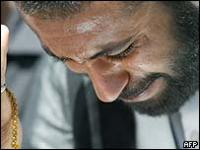







|
News and Information
Stampede illustrates Iraq tensions
| September 2, 2005 |

By Jon Brain
BBC News, Baghdad
Iraqis are still mourning the victims of the stampede
Once again Friday morning Baghdad awoke to the sounds of explosions followed by intermittent gunfire.
Plumes of smoke were soon seen rising from near the fortified green zone and a hotel close to the city centre.
Iraqis have become so immunized to this daily diet of violence that today's incidents will rate little more than a passing mention as they go about their normal business.
However, although Iraq has become accustomed to the death and destruction caused by insurgents, its politicians are facing a more worrying spectre: the possibility that one day sectarian tensions may spill over into a civil war.
Last night a 12-year-old girl from a Sunni neighbourhood was shot dead the same bridge in Baghdad that was the scene of Wednesday's stampede in which hundreds of Shia worshippers were killed.
The shooting followed a demonstration by Shias who marched towards the bridge carrying a spent mortar shell which had been fired into the crowds in the hours before the fatal stampede began.
Soldiers guarding the bridge fired into the air.
Residents of a Sunni community on the other side of the river thought they were coming under attack from the demonstrators and a short gun battle ensued during which the girl was killed and a number of other people were injured.
The incident was caused by a misunderstanding and was quickly over. But it provides another graphic illustration of the tensions bubbling away below the surface within some of Iraq's communities.
Resignation Calls
It's these tensions that the country's politicians are so desperate to contain, hence their repeated calls for national unity.
The question is, how can Iraq's leaders encourage unity from their compatriots when they appear so disunited themselves.
There have been calls for the resignation of Interior Minister Bayan Jabr
Within hours of Wednesday's disaster the Health Minister, a Shia was calling on the Defence Minister, who is a Sunni, to resign, accusing him of having failed to protect the worshippers from harm.
Abdul Mutalib Ali also called for the resignation of the Interior Minister, a Shia.
A display of even-handedness? Not really. Two of the ministers involved may be Shia but they're from different sects with completely contrasting views on the future direction Iraq should take.
And while cabinet members argue among themselves, the government as a whole has hardly helped lower the temperature by pinning the blame for Wednesdays tragedy squarely on Saddam loyalists.
It accuses them of infiltrating the crowds and spreading rumours of an imminent suicide attack in a calculated attempt to cause panic.
'Woeful mismanagement'
Critics believe the government is simply trying to deflect attention away from what they claim was its woeful mismanagement of security for the Shia ceremony.
In fact, those who have perhaps done most to help contain the potential for bloodshed come from perhaps unexpected quarters.
It's reported that during Wednesday's disaster men from the Sunni neighbourhood near the bridge waded into the River Tigris to help rescue worshippers.
While in Falluja, a Sunni stronghold, around three hundred people went to their local hospitals to donate blood to be sent to hospitals in Baghdad treating the injured.
Not for the first time the ordinary people of Iraq have demonstrated they can co-exist peacefully, even if some of their leaders find it difficult to resist comments which risk deepening Iraq's already serious divisions.
|
Source: www.bbc.com |
| http://news.bbc.co.uk/2/hi/middle_east/4208262.stm |
|
| Support Caprivi Freedom |
Fill out the form below to become a member of this site and receive our regular newsletter.
|

|

